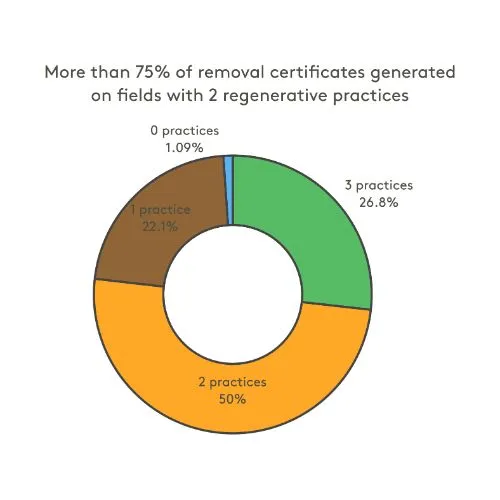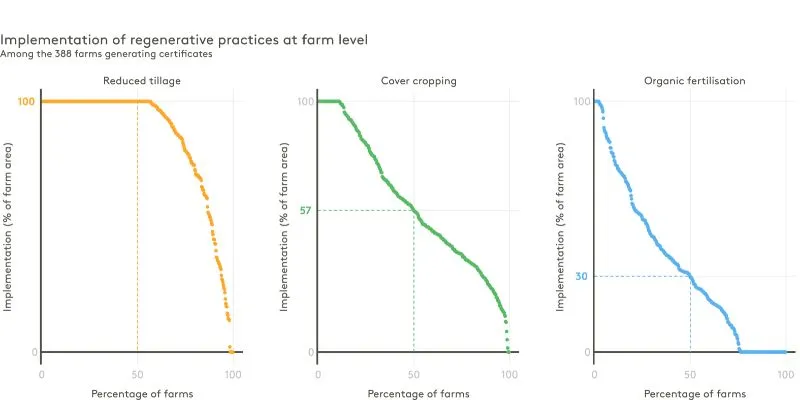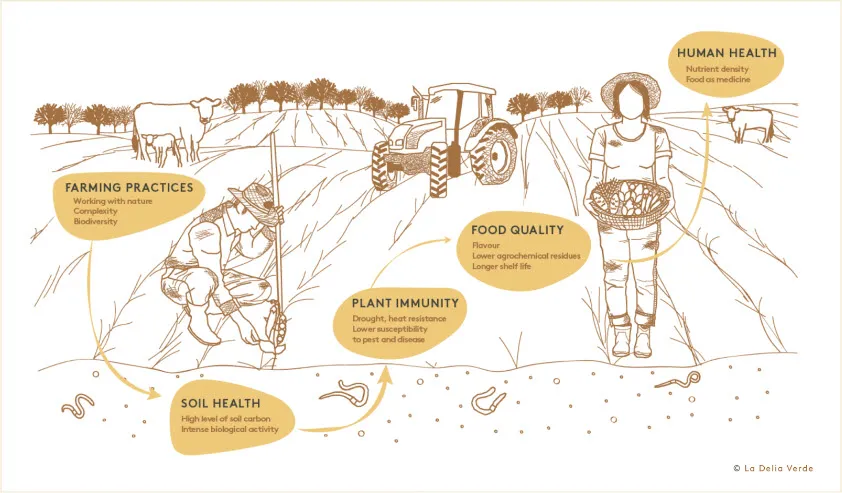





It’s been three years since Soil Capital launched its regenerative agriculture transition programme, which rewards farmers for their ecosystem services and critical contribution to a healthy planet and society. Our programme seeks to support the work of pioneering farmers and accelerate the transition to regenerative agriculture - but is it succeeding in its mission? What impact is carbon certification having on the ground, if any at all? What have we learned so far?
Regenerative agriculture leads to rapid decarbonisation in farms, revealing its important mitigation capacity. 75% of farms recorded a year-on-year improvement in their GHG balance, seeing clear changes as from their first year in the programme. Regenerative methods can hence be applied beneficially and quickly cut carbon emissions over conventional & organic farmland.
In the charts below, each vertical line represents the overall GHG balance of an individual farm on a per hectare level. Red lines above the horizontal axis are net emitting GHGs over the course of a year. Green lines below are farming systems that are net storing carbon from the atmosphere each year.


Payments for carbon performance are a meaningful and effective incentive for farmers to transition to regenerative agriculture. We have seen healthy growth in farmer enrolment in our programme over the past 2-3 years. From an initial intake of 100 farmers in 2020, our programme has now grown to more than 1,000 farmers in 2023 spread across France, Belgium and the UK.
The rapid growth in numbers reveals the pull that rewarding farmers for their carbon performance can have. Indeed, the new revenue stream from carbon certificates (with certificates only generated ex-post, once carbon results are quantified and audited) and Soil Capital’s expert guidance helps farmers bridge some of the barriers to adopting regenerative practices (such as fear over loss of profitability & yield, lack of appropriate knowledge, lack of market demand etc).

There is no one-size-fits-all formula for implementing regenerative agriculture. Farmers will implement different methods at different rates according to their specific local context (varying soil composition, climate, topography market etc), embarking on an ever-improving and ever-learning process toward healthy soil.
While some regenerative agriculture schemes prescribe certain practices, we leave farmers in full control over deciding which combination of practices to implement. We help to inform decision-making through tailored advice and agronomic expertise, but nothing is prescribed. We find this is better for ownership and for practice change that is adapted to local contexts.
Naturally, we see significant variability in the rate and degree of change between farmers as a result, as showcased in the graph below. The median change from one year to another in the GHG balance of all farms, across all years and cohorts, has been 0.23 tonne CO2e per hectare in our programme. By definition, half of the programme’s farmers achieve a rate of change higher than this, with plenty achieving improvements of more than 1 tonne CO2e per hectare per year.

More than 75% of carbon certificates generated by additional carbon storage after Harvest 2022 resulted from at least two different soil improvement practices being implemented in the same field that year. More than 25% of payments resulted from implementation of three soil improvement practices. This comes to show that despite the flexibility offered to farmers, farmers are implementing multiple practice changes at once - which is more compatible with a holistic approach to soil health improvement.

Holistic practice change is difficult and regenerative methods have varying rates of adoption. For farmers entering our programme, we typically recommend reduced tillage, cover cropping and organic fertilisation as the first methods to adopt in their regenerative transition. We have noted variations in the rate of adoption of these three methods, with farmers typically starting by reducing the intensity of their tillage, then introducing more cover cropping in their rotation, before finally shifting from full reliance on synthetic inputs (unless they are already organic) to a blend of synthetic and organic fertilisers.
This is seen in the below charts which compare the proportion of farms in our programme against their corresponding proportion of practice implementation. What can be seen is that:
There is an understandable logic to this trend. Access to organic fertiliser supply, for example, is a major constraint for many arable farmers as a result of current farming trends.

Often brought up in climate mitigation conversations, regenerative agriculture can be misunderstood as an approach which focuses exclusively on carbon - what some call “carbon tunnel vision”. This is erroneous, however.
Regenerative practices have holistic impacts across multiple areas, with carbon improvements only being one of them. Indeed, regenerative agriculture is as much a strategy for climate mitigation as it is for improving the performance of overall agroecological systems.
The European Commission has aggregated scientific evidence on regenerative practices’ widespread benefits. For instance, when farmers establish cover crops (keeping soil covered with living roots) studies show that this not only results in the storage of soil carbon, but also positive impacts for:
Our data shows that every single farmer that has generated GHG balance improvements after harvest 2022 has implemented some form of soil improvement practice such as cover cropping, organic fertilisation or reduced intensity tillage. This serves to show that working to improve the GHG balance of a farming system (taking both its emissions and soil carbon into account) also indicates improvements in soil health. As such, our programme uses carbon (and its equivalent greenhouse gases) as a leading indicator of regenerative agriculture implementation.

Data from Soil Capital’s programme acts as critical evidence that:
Nevertheless, we must also recognise that: (1) we are early in the evolution of our own programme - and therefore the insights that we can derive based on the data we have; (2) this is not a journey to travel alone - partnerships and the pooling of expertise are vital.
That’s why we participate in research projects funded by the European Union and UK Government with leading universities and researchers, looking at how different sensor technologies can add granularity to measuring the impact of our programme - including using microphones to listen to worm activity underground.
And, of course, we are always willing to join forces with other companies looking to accelerate the agricultural transition in appropriate ways, so don’t hesitate to get in touch!


It’s been three years since Soil Capital launched its regenerative agriculture transition programme, which rewards farmers for their ecosystem services and critical contribution to a healthy planet and society. Our programme seeks to support the work of pioneering farmers and accelerate the transition to regenerative agriculture - but is it succeeding in its mission? What impact is carbon certification having on the ground, if any at all? What have we learned so far?
Regenerative agriculture leads to rapid decarbonisation in farms, revealing its important mitigation capacity. 75% of farms recorded a year-on-year improvement in their GHG balance, seeing clear changes as from their first year in the programme. Regenerative methods can hence be applied beneficially and quickly cut carbon emissions over conventional & organic farmland.
In the charts below, each vertical line represents the overall GHG balance of an individual farm on a per hectare level. Red lines above the horizontal axis are net emitting GHGs over the course of a year. Green lines below are farming systems that are net storing carbon from the atmosphere each year.


Payments for carbon performance are a meaningful and effective incentive for farmers to transition to regenerative agriculture. We have seen healthy growth in farmer enrolment in our programme over the past 2-3 years. From an initial intake of 100 farmers in 2020, our programme has now grown to more than 1,000 farmers in 2023 spread across France, Belgium and the UK.
The rapid growth in numbers reveals the pull that rewarding farmers for their carbon performance can have. Indeed, the new revenue stream from carbon certificates (with certificates only generated ex-post, once carbon results are quantified and audited) and Soil Capital’s expert guidance helps farmers bridge some of the barriers to adopting regenerative practices (such as fear over loss of profitability & yield, lack of appropriate knowledge, lack of market demand etc).

There is no one-size-fits-all formula for implementing regenerative agriculture. Farmers will implement different methods at different rates according to their specific local context (varying soil composition, climate, topography market etc), embarking on an ever-improving and ever-learning process toward healthy soil.
While some regenerative agriculture schemes prescribe certain practices, we leave farmers in full control over deciding which combination of practices to implement. We help to inform decision-making through tailored advice and agronomic expertise, but nothing is prescribed. We find this is better for ownership and for practice change that is adapted to local contexts.
Naturally, we see significant variability in the rate and degree of change between farmers as a result, as showcased in the graph below. The median change from one year to another in the GHG balance of all farms, across all years and cohorts, has been 0.23 tonne CO2e per hectare in our programme. By definition, half of the programme’s farmers achieve a rate of change higher than this, with plenty achieving improvements of more than 1 tonne CO2e per hectare per year.

More than 75% of carbon certificates generated by additional carbon storage after Harvest 2022 resulted from at least two different soil improvement practices being implemented in the same field that year. More than 25% of payments resulted from implementation of three soil improvement practices. This comes to show that despite the flexibility offered to farmers, farmers are implementing multiple practice changes at once - which is more compatible with a holistic approach to soil health improvement.

Holistic practice change is difficult and regenerative methods have varying rates of adoption. For farmers entering our programme, we typically recommend reduced tillage, cover cropping and organic fertilisation as the first methods to adopt in their regenerative transition. We have noted variations in the rate of adoption of these three methods, with farmers typically starting by reducing the intensity of their tillage, then introducing more cover cropping in their rotation, before finally shifting from full reliance on synthetic inputs (unless they are already organic) to a blend of synthetic and organic fertilisers.
This is seen in the below charts which compare the proportion of farms in our programme against their corresponding proportion of practice implementation. What can be seen is that:
There is an understandable logic to this trend. Access to organic fertiliser supply, for example, is a major constraint for many arable farmers as a result of current farming trends.

Often brought up in climate mitigation conversations, regenerative agriculture can be misunderstood as an approach which focuses exclusively on carbon - what some call “carbon tunnel vision”. This is erroneous, however.
Regenerative practices have holistic impacts across multiple areas, with carbon improvements only being one of them. Indeed, regenerative agriculture is as much a strategy for climate mitigation as it is for improving the performance of overall agroecological systems.
The European Commission has aggregated scientific evidence on regenerative practices’ widespread benefits. For instance, when farmers establish cover crops (keeping soil covered with living roots) studies show that this not only results in the storage of soil carbon, but also positive impacts for:
Our data shows that every single farmer that has generated GHG balance improvements after harvest 2022 has implemented some form of soil improvement practice such as cover cropping, organic fertilisation or reduced intensity tillage. This serves to show that working to improve the GHG balance of a farming system (taking both its emissions and soil carbon into account) also indicates improvements in soil health. As such, our programme uses carbon (and its equivalent greenhouse gases) as a leading indicator of regenerative agriculture implementation.

Data from Soil Capital’s programme acts as critical evidence that:
Nevertheless, we must also recognise that: (1) we are early in the evolution of our own programme - and therefore the insights that we can derive based on the data we have; (2) this is not a journey to travel alone - partnerships and the pooling of expertise are vital.
That’s why we participate in research projects funded by the European Union and UK Government with leading universities and researchers, looking at how different sensor technologies can add granularity to measuring the impact of our programme - including using microphones to listen to worm activity underground.
And, of course, we are always willing to join forces with other companies looking to accelerate the agricultural transition in appropriate ways, so don’t hesitate to get in touch!
